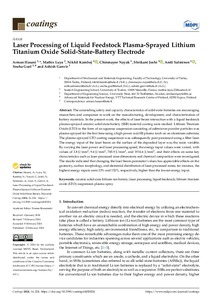Laser Processing of Liquid Feedstock Plasma-Sprayed Lithium Titanium Oxide Solid-State-Battery Electrode
Hasani Arman; Luya Mathis; Kamboj Nikhil; Nayak Chinmayee; Joshi Shrikant; Salminen Antti; Goel Sneha; Ganvir Ashish
Laser Processing of Liquid Feedstock Plasma-Sprayed Lithium Titanium Oxide Solid-State-Battery Electrode
Hasani Arman
Luya Mathis
Kamboj Nikhil
Nayak Chinmayee
Joshi Shrikant
Salminen Antti
Goel Sneha
Ganvir Ashish
MDPI
Julkaisun pysyvä osoite on:
https://urn.fi/URN:NBN:fi-fe2025082788233
https://urn.fi/URN:NBN:fi-fe2025082788233
Tiivistelmä
The astonishing safety and capacity characteristics of solid-state-batteries are encouraging researchers and companies to work on the manufacturing, development, and characterization of battery materials. In the present work, the effects of laser beam interaction with a liquid feedstock plasma-sprayed ceramic solid-state-battery (SSB) material coating were studied. Lithium Titanium Oxide (LTO) in the form of an aqueous suspension consisting of submicron powder particles was plasma-sprayed for the first time using a high-power axial III plasma torch on an aluminum substrate. The plasma-sprayed LTO coating suspension was subsequently post-processed using a fiber laser. The energy input of the laser beam on the surface of the deposited layer was the main variable. By varying the laser power and laser processing speed, the energy input values were varied, with values of 3.8 J/mm2, 9.6 J/mm2, 765.9 J/mm2, and 1914.6 J/mm2, and their effects on some key characteristics such as laser-processed zone dimensions and chemical composition were investigated. The results indicated that changing the laser beam parameter values has appreciable effects on the geometry, surface morphology, and elemental distribution of laser-processed zones; for instance, the highest energy inputs were 33% and 152%, respectively, higher than the lowest energy input.
Kokoelmat
- Rinnakkaistallenteet [27094]
